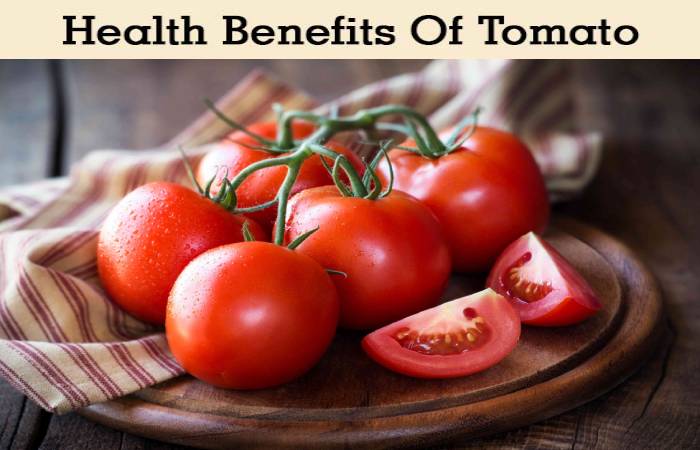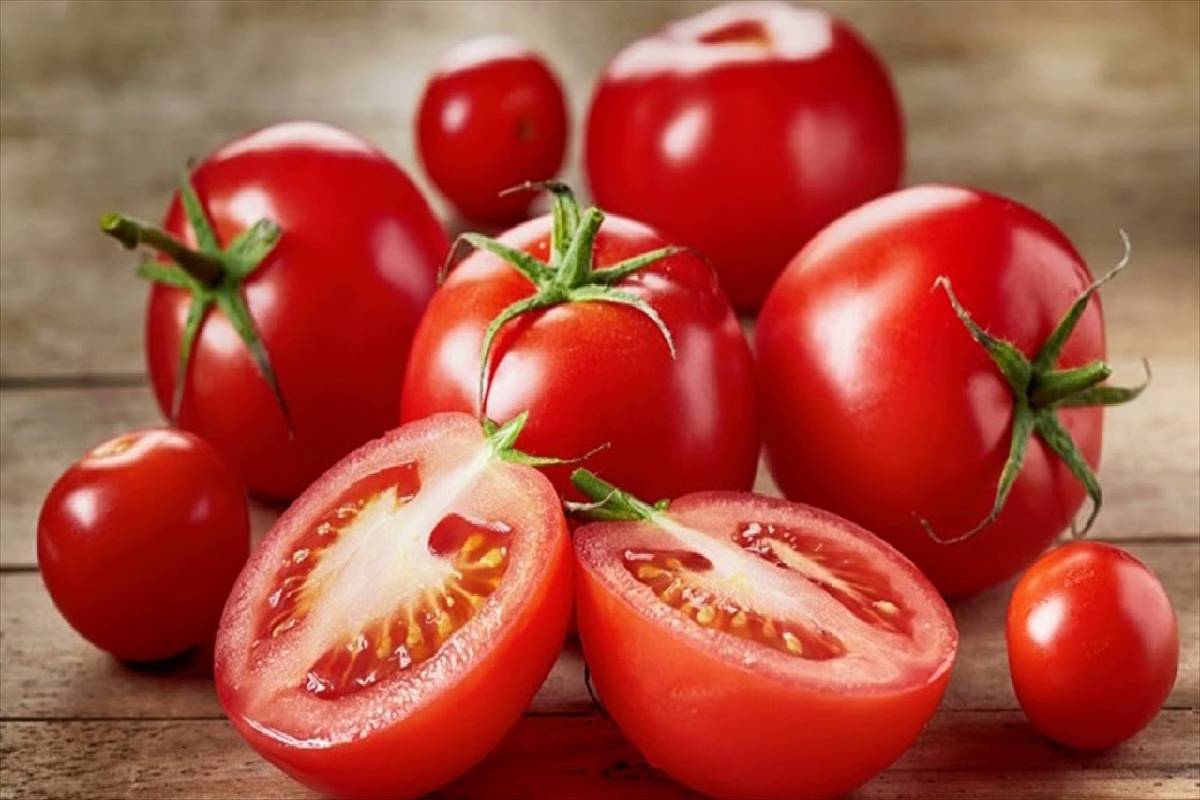Table of Contents
What is Tomato?
Tomato, a food that can be eaten curd or cooked, is one of the world’s most consumed fruits. It especially recommends for its nutritional contribution recommended for its benefits in our health.
We find an essential fruit to incorporate into our daily diet as millions of people around the world already do
What are the Health Benefits of Tomato?

1. Protect Eyesight
Vitamin A improves our vision, helps protect our eyes from degenerative diseases or night blindness.
2. Improves Blood Circulation
Tomato contains iron, a very healthy mineral in the blood’s excellent condition, and vitamin K that aids in control clotting. In this way, the tomato helps prevent cardiovascular diseases.
3. Take Care of the Skin
As it has excellent antioxidant properties, it is a natural remedy against aging and a great helper for the care of our skin, hair, and teeth.
4. Avoid Constipation
Its fiber content takes care of intestinal transit and prevents the appearance of diseases that have to do with the gastrointestinal organs.
5. Diuretic
It contains potassium and low levels of sodium, which helps prevent fluid retention and eliminate toxins.
6. Antioxidant
Rich in lycopene, an antioxidant more potent than vitamin E. Also, tomato contains other carotenes, making it a powerful antioxidant that takes care of our body.
Nutritional value of Tomato
Calories: 22
Proteins:1g
Total fat: 0.11
Carbohydrates: 3.5
Fiber (g): 1.4
Water (g): 94
Calcium (mg): 11
Iron (mg): 0.6
Magnesium (mg): 10
Zinc (mg): 0.22
Sodium (mg): 3
Potassium (mg): 290
Fo phosphorus (mg): 27
Vitamin B6 (mg): 0.11
Vitamin C (mg): 26, E (mg): 1.2
What are the Types of Tomato?

There is a great variety of tomatoes. Some types are original, as they became known after the arrival of the American continent, and other varieties are relatively new, resulting from the crossing of original varieties.
Despite the new varieties that have come out now, in our markets we can mainly find the following:
1. Raf
- It is a variety of tomato that many consider the best quality, but other types are better depending on the recipe we want to use.
- It is also called Pata Negra for its more than recognized quality.
- Its name is given by its initials RAF, which correspond to the initials Resistant to Fusarium, a pest that can affect these tomato plants’ lives.
- This type of tomato can use in countless recipes, both raw or preserved. It is irregular in shape with a crunchy texture and a sweet to sour taste.
2. Branch
- It is effortless to recognize if they have not yet been separated since several tomatoes group on their branch.
- It is medium in size with smooth, fair skin and intense red color.
- Its sour and sweet taste makes it ideal for eating in salads.
3. Rose of Barbastro
- It has a delicious sweet to citrus flavor and a delightful smell that is highly appreciated by consumers.
- It has a pink color that lives up to its name.
- They are usually large and irregular in size with thin and delicate skin.
- Its most used consumption is in salad recipes or only with olive oil and salt.
4. Pear
- As its name suggests, it is pear-shaped due to its similarity to these somewhat elongated fruits.
- It has a red color with an intensity that varies according to its point of maturity. It has smooth, shiny, and uniform skin.
- Its flavor is sweet, and its use in recipes for sauces or gazpachos, and it is one of the most used to make preserves both whole and ground.
5. Rome
- It is an ideal tomato for frying or for making both Salmorejo and gazpacho.
- It is a tomato of Italian origin known as a plum tomato used to make the famous tomato paste or preserve.
6. Kumato
- It is an example of a cross mix of other types of tomatoes.
- With a sweet taste and a very dark red, almost black color, it is round in shape and is the quintessential tomato to eat in a salad, although in gourmet cuisine.
- It uses in recipes for pistes, meals made in the oven, among other dishes.
- As a curiosity, it is a very antioxidant food since it has lycopene in its skin to a greater extent.
7. Ox Heart
- It looks like a heart, is usually large, sweet in taste, has few seeds inside, and has much pulp.
- It is a very resistant tomato and is used to consume in a salad.
8. Cherry
- It is tiny, so it is also called cherry tomato because of its similarity to this fruit.
- It widely uses in salad recipes, garnishes, or plate decorations.
- Its texture is crunchy with a sweet flavor. Its shape is round, and with a thin skin, we can find it yellow, green, or black, although deep red is the most common.
Origin of Tomato
- The tomato is the tomato plant’s fruit (Solanum Lycopersicum) and belongs to the Solanaceae family, such as potatoes, peppers or aubergines, all of South American origin.
- The exchange of food, after the conquest of the new world by Europe, this fruit began to be part of the diet in Mediterranean countries such as Spain or Italy.
- As a curiosity, the first tomatoes that arrived in Europe were not red but yellow.
- For this reason, in Italy, this fruit is known as Pomodoro, which means golden or yellow apple.
- It was first used in the kitchen as a decorative ingredient and not mainly a culinary one.
- Even botanists spoke of its possible toxicity when ingested. Nothing could be further from the truth.
- It soon became an indispensable ingredient in Mediterranean cuisine to this day. It was not until the 19th century that it began to be cultivated in other countries outside the Mediterranean.
- Tomato is currently one of the most expended and popular fruits on all continents.
How do you Eat the Tomato?
- Tomato, also known as tomato, consume both fresh and cooked in different recipes for salads, sauces, purees, fruit smoothies, or by transforming the sauce into soup or other broths or stews.
- It increases the intake of lycopene that I will talk about the properties of the tomato.
- It is an essential ingredient in the diet of different types of cuisines worldwide, but specifically, it is a necessary ingredient in salads, stews, and stir-fries of Mediterranean cuisine.
- Tomato establishes to consume fruits and vegetables times a day between cures and cooked as a food recommendation.
- We always recommend the consumption of fresh fruit to make the most of all its properties.
- In the case of tomato and being fresh, it is also very beneficial for our health to consume it cooked. The lycopene absorbs with triple efficiency after the heat has broken the cell membranes and has allowed it to escape.
- For this reason, the richest sources of lycopene are tomato sauce, puree, or concentrate, and better if we use ripe tomatoes.
- As a tip, it is advisable not to mix the tomato with vinegar since this mixture produces gases that can be annoying with specific pathologies.
What is the Tomato Season?
- The natural season for tomatoes is in summer.
- We can get tomatoes throughout the year, but the best time to savor and taste the best quality tomatoes is between June to October.
- Depending on our region’s climate, the time to harvest tomatoes may vary, but in most Mediterranean areas, the tomatoes are already ripe for harvest between mid-June and mid-October.
- The ideal is to consume them as we collect them so that their nutritional properties are the most optimal.
How is the Tomato Preserved?
- It is advisable to buy tomatoes in season, and local markets have grown varieties in our region.
- Tomatoes lose their aroma when stored in the cold in refrigerators.
- If we will consume it soon, it is advisable to keep them at room temperature out of the light.
- In this way, we will consume this fruit with all its aroma and flavor.
Conclusion
Also, suppose it comes from a cultivated plant. In that case, it is also a food that, due to its flavor, aroma, and nutritional properties beneficial to health, can be eaten raw when it reaches the optimal state of maturity like other fruits.
We can also observe that all fruits contain the plant’s seeds, and the tomato is no exception.
Also Read: Irritable Bowel Syndrome – Definition, Symptoms, Causes, and More

